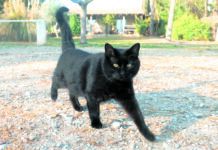Having lived in a city for the majority of my life, I really enjoy the improvement in my quality of life since I moved to upstate New York about five years ago. And my cats definitely appreciate the change in location. Back then, a view from an apartment window revealed mostly traffic and pedestrians. Not a large number of birds and squirrels, and the lack of a truly comfortable place to perch anyway (apparently, a narrow windowsill is passable for a short stint, but hardly ideal).
Now, I have an enclosed porch for all of us to enjoy. During the warmer months, the cats have access to the porch day and night. I provided a bird feeder that, this year, has attracted a flashy cardinal and the usual family of squirrels. The cats never tire of this, and now the creatures outside seem to have figured out that the cats are enclosed in a little “zoo” where they can be observed quite safely during snack-time!
And needless to say, the spring and summer months also bring with them a collection of insects. Screens are good at keeping them at bay, but it’s inevitable to get the errant moth and other flying bugs in the house. This is always evident when I catch my two cats stalking and chasing some seemingly invisible entity — and this game can last for a significant amount of time!
Cats chase and eat bugs because they love to pursue moving objects. It’s really quite simple. However, it’s important to realize that while most insects are safe for your cat to sample — you need to take special care to protect your pets from stinging insects, like yellow jackets, wasps and hornets.
If you notice your cat pursuing a bee or other stinging insect, get her away from it and sequestered in a safe room while you try to get the insect to leave your home or you decide to kill it. A sting can be very painful, and the resulting toxins can cause serious complications for your cat. The signs of a sting will include acute swelling and redness around the cat’s nose or face. He may yowl in pain or rub his paws on his face. If you notice these signs, take your cat to the veterinarian immediately.
Even more serious is if your cat manages to swallow a bee. This can be a life-threatening situation because the venom can cause the throat and airway to swell, jeopardizing your cat’s ability to breathe. You may see your cat struggling to breathe with an extended neck and an open mouth. This requires immediate veterinary intervention — you don’t have a minute to spare.



